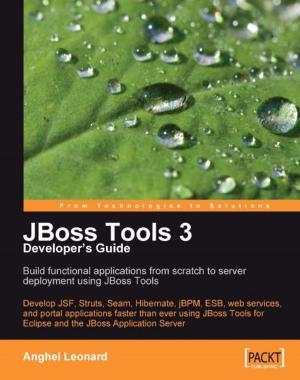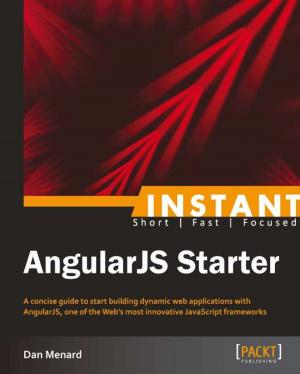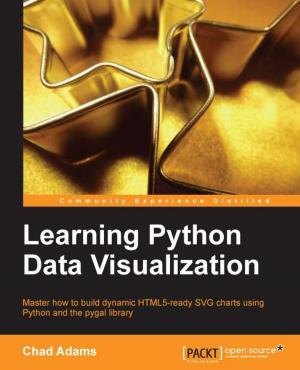Mastering Non-Functional Requirements
Nonfiction, Computers, Programming, Software Development, Internet| Author: | Sameer Paradkar | ISBN: | 9781788297899 |
| Publisher: | Packt Publishing | Publication: | May 18, 2017 |
| Imprint: | Packt Publishing | Language: | English |
| Author: | Sameer Paradkar |
| ISBN: | 9781788297899 |
| Publisher: | Packt Publishing |
| Publication: | May 18, 2017 |
| Imprint: | Packt Publishing |
| Language: | English |
This book covers the most critical 24 NFRs that are applicable to IT applications and systems.
About This Book
- Explains three stages of nonfunctional requirements, that is, analysis, architecture, and assessment
- In-depth knowledge of NFR framework and taxonomy that provides guidance around the modelling phase for the NFRs
- Coverage of 24 critical and pivotal NFRs, including the analysis, architecture, and assessment.
Who This Book Is For
The primary audience for this title are the gamut of roles starting from IT consultant to chief architects who are responsible to deliver strategic, tactical, and operational engagements for fortune 100 customers worldwide. Nonfunctional requirements are the key to any software / IT program. They cannot be overlooked or ignored. The book provides a comprehensive approach from analysis, architecture, and measurement of nonfunctional requirements. The book includes considerations for bespoke (Java, .Net, and COTS applications). These are applicable to IT applications from various domains. The book outlines the methodology for capturing the NFRs and also describes a framework that can be leveraged by analysts and architects for tackling NFRs for various engagements. The audience for this book include business analysts, enterprise architects, business architects, solution architects, technical architects/designers, domain/security/integration architects, software developers, support engineers and test engineers, technical project managers, project leads/technical leads/technical project managers, and students from the computer science/IT stream
What You Will Learn
- Learn techniques related to the analysis, architecture, and monitoring of NFRs
- Understand the various tools, techniques, and processes in order to improve the overall quality of the desired outcomes
- Embrace the best practices of architecting, metrics, and success factors for NFRs
- Identify the common pitfalls to be avoided and the patterns to leverage
- Understand taxonomy and framework for NFRs
- Learn the design guidelines for architecting applications and systems relating to NFRs
- Abstract different methodologies to analyze and gather NFRs
In Detail
Non-functional Requirements are key to any software/IT program and cannot be overlooked or ignored. This book provides a comprehensive approach to the analysis, architecture, and measurement of NFRs. It includes considerations for bespoke Java, .NET, and COTS applications that are applicable to IT applications/systems in different domains.
The book outlines the methodology for capturing the NFRs and also describes a framework that can be leveraged by analysts and architects for tackling NFRs for various engagements.
This book starts off by explaining the various KPIs, taxonomies, and methods for identifying NFRs. Learn the design guidelines for architecting applications and systems relating to NFRs and design principles to achieve the desired outcome. We will then move on to various key tiers/layers and patterns pertaining to the business, database, and integrating tiers. After this, we will dive deep into the topics pertaining to techniques related to monitoring and measurement of NFRs, such as sizing, analytical modeling, and quality assurance.
Lastly, we end the book by describing some pivotal NFRs and checklists for the software quality attributes related to the business, application, data, and infrastructure domains.
Style and approach
The book takes a pragmatic approach, describing various techniques related to the analysis of NFRs, the architecture of NFRs, and assessment of NFRs.
This book covers the most critical 24 NFRs that are applicable to IT applications and systems.
About This Book
- Explains three stages of nonfunctional requirements, that is, analysis, architecture, and assessment
- In-depth knowledge of NFR framework and taxonomy that provides guidance around the modelling phase for the NFRs
- Coverage of 24 critical and pivotal NFRs, including the analysis, architecture, and assessment.
Who This Book Is For
The primary audience for this title are the gamut of roles starting from IT consultant to chief architects who are responsible to deliver strategic, tactical, and operational engagements for fortune 100 customers worldwide. Nonfunctional requirements are the key to any software / IT program. They cannot be overlooked or ignored. The book provides a comprehensive approach from analysis, architecture, and measurement of nonfunctional requirements. The book includes considerations for bespoke (Java, .Net, and COTS applications). These are applicable to IT applications from various domains. The book outlines the methodology for capturing the NFRs and also describes a framework that can be leveraged by analysts and architects for tackling NFRs for various engagements. The audience for this book include business analysts, enterprise architects, business architects, solution architects, technical architects/designers, domain/security/integration architects, software developers, support engineers and test engineers, technical project managers, project leads/technical leads/technical project managers, and students from the computer science/IT stream
What You Will Learn
- Learn techniques related to the analysis, architecture, and monitoring of NFRs
- Understand the various tools, techniques, and processes in order to improve the overall quality of the desired outcomes
- Embrace the best practices of architecting, metrics, and success factors for NFRs
- Identify the common pitfalls to be avoided and the patterns to leverage
- Understand taxonomy and framework for NFRs
- Learn the design guidelines for architecting applications and systems relating to NFRs
- Abstract different methodologies to analyze and gather NFRs
In Detail
Non-functional Requirements are key to any software/IT program and cannot be overlooked or ignored. This book provides a comprehensive approach to the analysis, architecture, and measurement of NFRs. It includes considerations for bespoke Java, .NET, and COTS applications that are applicable to IT applications/systems in different domains.
The book outlines the methodology for capturing the NFRs and also describes a framework that can be leveraged by analysts and architects for tackling NFRs for various engagements.
This book starts off by explaining the various KPIs, taxonomies, and methods for identifying NFRs. Learn the design guidelines for architecting applications and systems relating to NFRs and design principles to achieve the desired outcome. We will then move on to various key tiers/layers and patterns pertaining to the business, database, and integrating tiers. After this, we will dive deep into the topics pertaining to techniques related to monitoring and measurement of NFRs, such as sizing, analytical modeling, and quality assurance.
Lastly, we end the book by describing some pivotal NFRs and checklists for the software quality attributes related to the business, application, data, and infrastructure domains.
Style and approach
The book takes a pragmatic approach, describing various techniques related to the analysis of NFRs, the architecture of NFRs, and assessment of NFRs.















